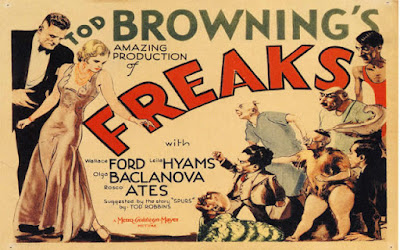“The Strangest... The Most
Startling Human Story Ever Screened... Are You Afraid To Believe What Your Eyes
See?” [1] . It isn’t the first
cult film, but it is the one most likely to be associated with cult cinema. It
is a story set in the world of the circus and sideshow performers and features
love, betrayal, loyalty, and revenge. The bulk of the story deals with a female
trapeze artist and a midget performer. Their world is an unusual one, as it
involves sideshow performers that are paid because they have physical
abnormalities.
There is so much to say about
this one that whole books could be solely devoted to it. It is the first movie
to show actual sideshow performers, people that were physically different than
everyone else. They are shown not as freaks, but as normal people doing
everyday routine things [2] . The connotation of
them being labeled as freaks or monsters is not necessarily because of their
appearance, as opposed to how they react to situations in the picture. There
are so many themes going on; what defines a monster, the idea of a code of
loyalty, and the role of violence in society [3] .
The movie was an attempt by MGM
to compete with Universal Studios
and the popularity of its monster films such as Frankenstein [4] . Director Todd Browning
had a background in the sideshow circus and he had previously done some motion
pictures about physical deformities with the legendary horror actor Lon Chaney [4] . Circus
stories were “going out of vogue” and horror was doing well in the film
industry, so Browning thought he could merge both of the worlds together [2] . The Great Depression
and the effects of the war also made it an easier idea to show abnormalities,
as there were more physically disabled people visible and it was viewed more as
a “medical problem” [2] .
Producer Irving Thalberg also had an interest in the unusual, so
they wanted Browning to come up with something that would top Dracula and everything else before it and
create the most horrifying film yet [4] . Harry Earles had
pitched the short story Spurs, which
is what the movie is based on, because
it was hard for little people to get much work [4] . Originally it was
meant for Lon Chaney, but he died in 1930 [4] .
The critical reception was mostly bad and the box office numbers
were mixed, there were a lot of theaters that would refuse to even show the picture [3] . Add to that
complaints from various organizations and it was pulled by MGM and pretty much
locked away for thirty years [4] . Despite being
released before the Hayes code and stricter ratings, its graphic “depictions of physical
abnormalities, sex, violence and perceived exploitation” led to it being pulled
from theaters and being banned [5] . Its revival came during the 1960’s with the
avant-garde art scene and exploitation drive in shows [3] .
The acting may appear weak, but the story and direction are very
strong. Browning had spent most of his career making horror films and provides
us with a dreadfully thrilling movie that doesn’t involve one of the standard
Universal monsters. Many of the current issues are the quality of the surviving
prints. The picture quality is substandard and the audio is poor and scratchy,
making it difficult to understand Earles high pitched voice at times.
The film has its importance even if there may be some flaws. Never
before had there been so many world class sideshow performers assembled into
one act as there was for this movie, not in Ringling Brothers or any other
circus. It was also very unusual for a group of little people to be cast as
actual main characters with a lot of dialogue. If you are a cult film fan then
this is essential viewing.
Works Cited
[1]
|
"IMDB,"
IMDB, 26 1 2016. [Online]. Available: http://www.imdb.com/title/tt0022913/taglines?ref_=tt_stry_tg.
[Accessed 26 1 2016].
|
[2]
|
I. R. Hark, American
Cinema of the 1930s, New Brunswick: Rutgers, 2007.
|
[3]
|
J. Hawkins, Cutting
Edge, Minneapolis: Regents, 2000.
|
[4]
|
Freaks
Anniversary Documentary. [Film].
TCM.
|
[5]
|
S. Mccarthy, Cult
Movies in 60 Seconds, London: Fusion Press, 2003.
|

No comments:
Post a Comment